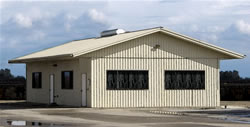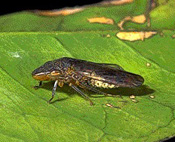ANR news blog
Sensory lab a Fresno Bee sensation
The new sensory laboratory at the UC Kearney Research and Extension Center won high visibility over the weekend in a prominent story on the front page of the Fresno Bee business section. The new lab was dedicated in April and is the subject of the ucanr.org feature story for May.
Fresno Bee reporter Dennis Pollock wrote that sensory research mixes science with people's senses -- especially taste -- to come up with fruit that shoppers are more likely to enjoy.
"Such results will benefit not only the consumer but our agricultural industries," the article quoted Mary Lu Apaia, a UC Riverside sub tropical horticulturalist based at Kearney.
The story said the new lab takes the place of a "makeshift" facility with less than optimal conditions because of distracting sounds from cooling equipment and odors from fruit stored in a freezer.
"This is a people science. People [the tasters] are my instruments," it quoted staff research associate Sue Collin. "I don't want any distractions."
The Fresno Bee story included mention of all the commodity and grower groups who contributed cash to construct the new laboratory.

The new KREC sensory lab.
Heat wave generates hits
With a heat wave settling in on California for the next few days, the UC ANR news and information office shared its collection of helpful information for preventing heat stress in outdoor workers, which is compiled in a media kit on the news and information Web site, http://news.ucanr.org. The news release went out yesterday, and the information was made available to the Fresno Bee's 157,546 readers this morning.
Cool!
Glassy-winged sharpshooter back in the news
Glassy-winged sharpshooters made a tremendous spash in the California media back in the 90s when they were first introduced into California and began spreading Pierce's disease in grapes. They were never far from the minds of grape researchers and farmers, but the stories in the press almost completely disappeared. Until yesterday.
The Riverside Press Enterprise ran a 500-word story about renewed concerns of a Pierce's disease outbreak in Temecula wine country. According to the article, a grower and a UC Riverside scientist are warning that not enough wineries are applying a pesticide that kills the glassy-winged sharpshooter.
UC Riverside entomologist Nick Toscano told the paper that as many as 40 percent of Temecula-area wineries do not apply the pesticide to control GWSS, which sets the winery back $175 to $210 an acre.
There have been no widespread outbreaks of Pierce's disease since the late 1990s, but sharpshooters are still found in local vineyards, according to the article. The week of April 28, it said, close to 40 sharpshooters were caught in UC Riverside's sticky traps.
An interesting side note: The Press Enterprise posted a four-minute podcast with the story, which is simply an automated text reader robotically saying the words in the story.

A GWSS poses on a leaf.
It's not easy being green
Kermit the Frog's cute lament about being green was used to introduce a story in the Vacaville Reporter recently on the movement to eat "green" by purchasing organic food.
Organic producers say their products are more nutritious, safer, tastier and better for the environment because herbicides and pesticides are not used, wrote freelance reporter Elizabeth Long.
Critics, however, say organic agriculture requires more land to produce the same amount of food, land that should be conserved for wildlife.
For the story, Long spoke with Tom Tomich, director of the Agricultural Sustainability Institute housed at UC Davis. According to the article, he noted that organic production makes sense in the highly productive Sacramento Valley.
The risk of lower crop yields could be balanced by the benefit of fewer pesticides in the air and water, the article said. Selling to local metropolitan areas, such as Sacramento and San Francisco, could also reduce greenhouse gas emissions from transportation.
In other parts of the world, being green won't be so easy. Africa and Asia may have to look to other methods to grow food as their populations increase and the cost of importing foreign crops rises with fuel prices, according to Long's story.
Kermit couldn't be more right.
Garbanzos touted as low-cost protein source
The Fresno Bee's ag savvy food writer, John Obra, wrote an article for today's Life section on fresh garbanzos, with information gleaned at a recent UC Cooperative Extension garbanzo bean field day at the UC West Side Research and Extension Center.
High-protein garbanzo beans, also known as chick peas, are most familiar to consumers as dried bagged beans or cooked canned beans. Obra says the green fresh beans will be harvested during the next few weeks and make their way into the produce section of grocery stores.
The article said young, fresh garbanzo beans are so highly sought after, they can be a poacher's quarry. At the field day, UC Davis Cooperative Extension specialist Steve Temple told stories of garbanzo farmers camping on their fields to prevent thieves from ripping up garbanzo plants for prized young, green legumes, Obra wrote.
In addition to offering recipes for using garbanzo beans, Obra's story noted that the legume adds nitrogen back to the soil as it grows.
These and other winter legumes "will definitely have a role 10 to 20 years from now in California agriculture because of low water requirements and nitrogen fixation," Temple was quoted.
